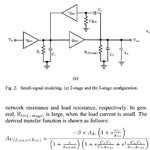whompah
Newbie level 6

- Joined
- Apr 10, 2012
- Messages
- 11
- Helped
- 0
- Reputation
- 0
- Reaction score
- 0
- Trophy points
- 1,281
- Activity points
- 1,375
Hi everyone, I am trying to derive the transfer function based on the small signal diagram given below, it is LDO regulator. It is found in this journal
https://ieeexplore.ieee.org/xpl/articleDetails.jsp?tp=&arnumber=6297490&queryText=ldo

I derived manually using KCL based on the diagram and I couldn't express the final form as shown in the attachment, but I tried to equate my coefficient of s^3 and that one in the diagram and they turned out to be the same ! So I assumed that my approach is correct.
Anyhow, is there any more appropriate or more correct way of deriving the transfer function just like those who published their journals ?
Help is appreciated
https://ieeexplore.ieee.org/xpl/articleDetails.jsp?tp=&arnumber=6297490&queryText=ldo

I derived manually using KCL based on the diagram and I couldn't express the final form as shown in the attachment, but I tried to equate my coefficient of s^3 and that one in the diagram and they turned out to be the same ! So I assumed that my approach is correct.
Anyhow, is there any more appropriate or more correct way of deriving the transfer function just like those who published their journals ?
Help is appreciated

